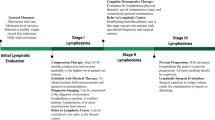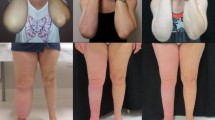Abstract
Background
Melanoma is a malignant tumour of melanocytes, which are found predominantly in skin, and at least 10–45% of patients develop secondary lymphedema (SL).
Purpose
This study seeks to investigate if individual’s lymphatic system can benefit from complete decongestive physical therapy (CDPT) 1 year after discharge from CDPT and consequently endorsing a better quality of life.
Methods
Male and female(n = 12) melanoma survivors 1–4 years post diagnosis with unilateral SL. Questionnaire and limb measurements were used to asses retrospective outcomes.
Results
A significant improvements (p < 0.05) has been in the categories of localisation, staging, disability and symptoms of SL.
Conclusions
CDPT provides relief in signs and symptoms for patients with SL following groyne dissection.
Similar content being viewed by others
References
Kroon BB, Nieweg OE (2000) Management of malignant melanoma. Ann Chir Gynaecol 89(3):242–250
Rekha A, Ravi A, Venu N, Shivanraj A (2005) Malignant melanoma and filariasis: a coexistence or an association? Int J Low Extrem Wounds 4(1):60–64
Karakousis CP, Driscoll DL (1999) Treatment and local control of primary extremity soft tissue sarcomas. J Surg Oncol 71(3):155–161
Brouns E, Donceel P, Stas M (2008) Quality of life and disability after ilio-inguinal lymphadenectomy. Acta Chir Belg 108(6):685–690
Campisi C, Boccardo F, Alitta P, Tacchella M (1995) Derivative lymphatic microsurgery: indications, techniques, and results. Microsurgery 16(7):463–468
Casley-Smith JR (1992) A model of the factors affecting interstitial volume in oedema. Part I: hierarchies, some new factors and their equations. Biorheology 29(5–6):535–548
Bowsher WG, Taylor BA, Hughes LE (1986) Morbidity, mortality and local recurrence following regional node dissection for melanoma. Br J Surg 73(11):906–908
Gerber LH (1998) A review of measures of lymphedema. Cancer 83:2803–2804
Adamsen L, Midtgaard J, Rorth M, Borregaard N, Andersen C, Quist M, Møller T, Zacho M, Madsen JK, Knutsen L (2003) Feasibility, physical capacity, and health benefits of a multidimensional exercise program for cancer patients undergoing chemotherapy. Support Care Cancer 11(11):707–716
Drake D, Falzer P, Xistris D, Robinson G, Roberge M (2004) Physical fitness training: outcomes for adult oncology patients. Clin Nurs Res 13(3):245–264
Schwartz AL, Mori M, Gao R, Nail LM, King ME (2001) Exercise reduces daily fatigue in women with breast cancer receiving chemotherapy. Med Sci Sports Exerc 33(5):718–723
Foldi E, Földi M, Clodius L (1989) The lymphedema chaos: a lancet. Ann Plast Surg 22(6):505–515
Ko DS, Lerner R, Klose G, Cosimi AB (1998) Effective treatment of lymphedema of the extremities. Arch Surg 133(4):452–458
Shamley DR, Barker K, Simonite V, Beardshaw A (2005) Delayed versus immediate exercises following surgery for breast cancer: a systematic review. Breast Cancer Res Treat 90(3):263–271
Jones LW, Courneya KS, Fairey AS, Mackey JR (2004) Effects of an oncologist's recommendation to exercise on self-reported exercise behavior in newly diagnosed breast cancer survivors: a single-blind, randomized controlled trial. Ann Behav Med 28(2):105–113
Courneya KS, Friedenreich CM, Quinney HA, Fields AL, Jones LW, Fairey AS (2003) A randomized trial of exercise and quality of life in colorectal cancer survivors. Eur J Cancer Care (Engl) 12(4):347–357
Bernas MJ, Witte CL, Witte MH (2001) International society of lymphology executive committee. The diagnosis and treatment of peripheral lymphedema: draft revision of the 1995 consensus document of the international society of lymphology executive committee for discussion at the September 3-7, 2001, XVIII international congress of lymphology in Genoa, Italy. Lymphology 34(2):84–91
ISL- International Society of Lymphology The diagnosis and treatment of peripheral lymphedema (2003) Consensus document of the International Society of Lymphology. Lymphology 36(2):84–91
Paterson AG, Trask PC, Wagner LI, Esper P, Redman B (2005) Validation of the FACT-BRM with interferon-alpha treated melanoma patients. Qual Life Res 14(1):133–139
Chiarion-Sileni V, Del Bianco P, De Salvo GL, Lo Re G, Romanini A, Labianca R, Nortilli R, Corgna E, Dalla Palma M, Lo Presti G, Ridolfi R, Italian Melanoma Intergroup (IMI) (2003) Quality of life evaluation in a randomised trial of chemotherapy versus bio-chemotherapy in advanced melanoma patients. Eur J Cancer 39(11):1577–1585
Mayrovitz HN (2009) The standard of care for lymphedema: current concepts and physiological considerations. Lymphat Res Biol 7(2):101–108
Horning KM, Guhde J (2007) Lymphedema: an under-treated problem. Medsurg Nurs 16(4):221–227
Segal RJ, Reid RD, Courneya KS, Malone SC, Parliament MB, Scott CG, Venner PM, Quinney HA, Jones LW, D'Angelo ME, Wells GA (2003) Resistance exercise in men receiving androgen deprivation therapy for prostate cancer. J Clin Oncol 21(9):1653–1659
Jones LW, Courneya KS, Vallance JK, Ladha AB, Mant MJ, Belch AR, Stewart DA, Reiman T (2004) Association between exercise and quality of life in multiple myeloma cancer survivors. Support Care Cancer 12(11):780–788
Sagen A, Kåresen R, Risberg MA (2009) Physical activity for the affected limb and arm lymphedema after breast cancer surgery. A prospective, randomized controlled trial with two years follow-up. Acta Oncol 23:1–9
Hayes SC, Reul-Hirche H, Turner J (2009) Exercise and secondary lymphedema: safety, potential benefits, and research issues. Med Sci Sports Exerc 41(3):483–489
Balch C, Buzaid A, Soong S, Atkins M, Cascinelli N, Coit D, Fleming I, Gershenwald J, Houghton A, Kirkwood J, McMasters K, Mihm M, Morton D, Reintgen D, Ross M, Sober A, Thompson J, Thompson J (2001) Final version of the American joint committee on cancer staging system for cutaneous melanoma. J Clin Oncol 19(16):3635–3648
Mak SS, Yeo W, Lee YM, Mo KF, Tse KY, Tse SM, Ho FP, Kwan WH (2008) Predictors of lymphedema in patients with breast cancer undergoing axillary lymph node dissection in Hong Kong. Nurs Res 57(6):416–425
Mayrovitz HN, Sims N, Litwin B, Pfister S (2005) Foot volume estimates based on a geometric algorithm in comparison to water displacement. Lymphology 38(1):20–27
Mock V, Pickett M, Ropka ME, Muscari Lin E, Stewart KJ, Rhodes VA, McDaniel R, Grimm PM, Krumm S, McCorkle R (2001) Fatigue and quality of life outcomes of exercise during cancer treatment. Cancer Pract 9(3):119–127
Author information
Authors and Affiliations
Corresponding author
Rights and permissions
About this article
Cite this article
Carmeli, E., Bartoletti, R. Retrospective trial of complete decongestive physical therapy for lower extremity secondary lymphedema in melanoma patients. Support Care Cancer 19, 141–147 (2011). https://doi.org/10.1007/s00520-009-0803-3
Received:
Accepted:
Published:
Issue Date:
DOI: https://doi.org/10.1007/s00520-009-0803-3




